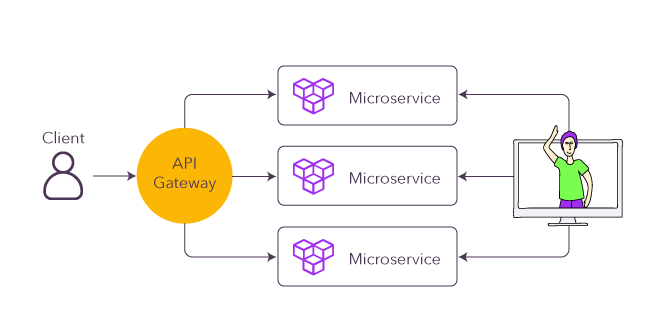How Microservices can Benefit Your Organization

We all know that Netflix has had a huge influence on how we consume, make, and purchase entertainment. But perhaps less understood is the role it’s played in the evolution of software development, particularly when it comes to the popularization of microservices. Back in 2009, just a couple of years after the introduction of its video streaming services, Netflix decided to migrate its IT infrastructure to the cloud and break down its monolithic software architecture into smaller service components that work together but independently of each other. Though the term wouldn’t be used for another few years, this was a landmark moment for microservices, the service-based software architecture pattern that one recent report estimates are now used by around three-quarters of businesses.
Why microservices?
Why has the microservices pattern become so mainstream? Rather than an application built as a single, autonomous unit, microservices refers to a system of multiple applications (‘microservices’) that can be developed, tested, and deployed independently of each other. This means large, complex applications can be broken down into smaller and more management building blocks that communicate with each other through simple Application Programming Interfaces (APIs). Crucially, each component is self-contained, meaning that developers can work on one microservice without disrupting the broader functionality of the whole application. Here are some of the main benefits that microservices can offer a business organization:

Productivity: In a monolithic pattern all components are connected and interdependent. So if a developer wants to add or update a specific feature they need to understand how it will affect all other components and coordinate with all other dev teams involved in the system. On a large application, this can have a big impact on workflow and delivery times. The microservices architecture keeps the development environment streamlined, so small teams can deploy, test, and update individual components simultaneously. This is especially significant with distributed teams, as developers have more autonomy and aren’t left waiting on others (perhaps based in another country) to complete a section of work.
Versatility: In a microservices pattern, each self-contained component can be built using different programming languages, databases, and structures. That provides more flexibility when it comes to choosing both the best available component for a particular function and the best developer to work on it. Ease of deployment also encourages experimentation with new technology stacks, reducing the risks of an application becoming dated or obsolete over time.
Scalability: Because each microservice component can be independently deployed and tested, it becomes easier to scale software at the pace you require without worrying about bottlenecks or spaghetti code. Microservices can also be replicated easily, making it relatively simple to add new resources as required.
Reduced risks: One of the factors that drove Netflix to adopt a microservices pattern was a glitch that brought down the entire site for 11 hours back in 2008. A tiny error in a monolithic pattern - the Netflix outage was reportedly triggered by a missing semicolon - can disrupt the entire system and have major costs. With microservices, this is highly unlikely, as the failure of a single component shouldn’t compromise the rest of the application. This dramatically reduces the risks and costs associated with bugs - developers can make changes to one service or roll back volatile updates without having to redeploy the entire application.
Microservices and Java
One of the advantages of microservices architecture is that it allows the incorporation of a wide range of programming languages and tools. One of the most popular choices is Java due to its simplicity, readability, stability, and deep pool of resources (both libraries and developers). The rapid take-up of microservices architecture, which could accelerate further during the great transition to remote work, makes it a valuable skill for all Java developers today. Fortunately, there are already several microservices frameworks for Java, including Spring (one of the most common and comprehensive options), Jersey, DropWizard Swagger, and Spark.
Some key considerations
Though a microservices model can bring numerous benefits to your organization, it’s not a silver bullet. These are some of the key things to consider if you’re thinking of adopting microservices.
Is it necessary? Microservices guru Martin Fowler says don't even consider microservices unless you have a system that's too complex to manage as a monolith. We’ve seen how microservices break down large and complex applications into more manageable components, but what if you’re working with a relatively small and simple system? Though the temptation to jump on popular trends is understandable, you first have to be sure that the additional planning requirements and resources associated with setting up and running a microservices application are worth it. Remember, if you’re a start-up it might be easier to begin with a monolithic application and then migrate to microservices if and when it becomes appropriate.
Make sure your company culture is suitable: One of the key benefits of microservices is related to productivity, as small and independent teams can work simultaneously on different components, staying fully focused on optimizing their solution. However, that also means that these teams need to have the expertise and experience to manage the end-to-end process. Good communication between teams is also essential, as they may not have a clear view of the ‘big picture’ while working on their microservices. This is especially the case when dealing with distributed teams. One increasingly popular approach is to adopt the agile methodology, which is a natural fit for working with microservices (you can read more about agile here).
Don’t neglect security: The modular nature of the microservices pattern inevitably expands the attack surface and number of potential vulnerabilities in a software system. Protection against cyberattacks is vital to any organization, so security must be a primary concern when migrating to a microservices architecture model. You can mitigate security risks by making use of tools such as firewalls, multi-factor authentication, and API gateways. Also, be sure to assess the potential risks of any open source microservices tool you wish to use in your system. Perhaps the best long-term approach is to make security a core feature of the application’s design, with development and security teams working side-by-side during the software life cycle.
--
If you want to stay up to date with all the new content we publish on our blog, share your email and hit the subscribe button.
Also, feel free to browse through the other sections of the blog where you can find many other amazing articles on: Programming, IT, Outsourcing, and even Management.

Santiago Mino, VP of Strategy at Jobsity, has been working in Business Development for several years now helping companies and institutions achieve their goals. He holds a degree in Industrial Design, with an extensive and diverse background. Now he spearheads the sales department for Jobsity in the Greater Denver Area.